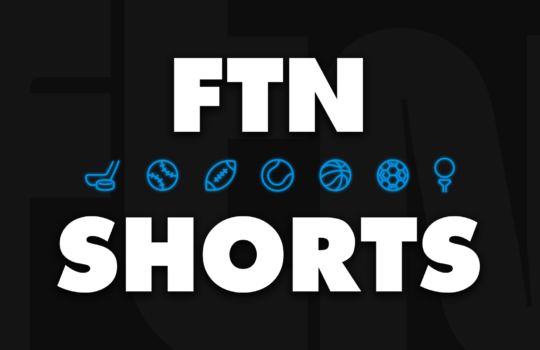
Every Monday, I find myself in a bit of NFL data purgatory. We’re waiting for the week to come to a proper ending, and the data is still yet to be finalized. It’s a great time, however, to look at some historical trends and do some digging on some things we can leverage in the upcoming week. This piece will be out Tuesdays but won’t have the same format or topic each week. The formula will change as I poke around with the data we have access to here. It’ll just be my musings on something that caught my eye. If there’s something to it, I’ll give you some way to leverage the conclusions in fantasy for the upcoming week.
Checking in on aYFOG
For the uninitiated, you can head back to the first edition of this piece for reference. YFOG is just as it sounds — 1 YFOG would be your own 1-yard line while 99 YFOG would be the opponent’s 1-yard line. This data point is entered into the play-by-play data for each play. Running a simple average on those numbers can help you get a feel for where a team is running the majority of their plays; we’ll call it aYFOG. The tl;dr version is that a team’s aYFOG (average yards from own goal) is correlated to scoring opportunities and captures a lot of information about a team into one metric. If a team is running many plays on their opponent’s side of the field, they’re more likely to score points.
Current aYFOG leaderboard
When we started looking at this metric about a month ago, there was a pretty similar list at the top. At that point, the Bills were more than two standard deviations above the historical league average. That has since regressed a bit, but they still occupy the top spot. Tampa Bay has leapfrogged into the top 5, while the Chargers have slid down the board from third to ninth place.
Regression candidates
There’s a lot going on here, so let’s start with a quick explainer for the viz. Anything within the white squares is inside of a standard deviation of the historical league averages for each metric. There are outliers in every metric every season, but we’d expect some of the teams that are very far from the regression line to regress at some point. A key understanding of this viz is that regression can occur in different directions. A team that is outperforming their aYFOG in points per game can improve in aYFOG just as easily as they can come down in points per game. We’d think that teams should score more or less based on their aYFOG, but if there’s enough of a signal that they’re a strong offense, their aYFOG can increase to match their PPG.
The Bengals are the biggest outlier in that regard. Based on their aYFOG, we’d expect them to be scoring about 18 points per game. They currently sit just above 27 PPG. That difference is the largest, by far, of any team in the NFL.
Most of that has to do with the fact that Ja’Marr Chase is making defenders look foolish every single week with long plays. My guess would be that some of those long plays aren’t necessarily going to repeat, and the Bengals start sustaining longer drives, thus increasing their aYFOG and scoring closer to their expected PPG.
The Bears and Lions are down at the other end of the spectrum. They’re scoring a full touchdown less than expected. Neither team shows much of a signal that would lead us to believe that they can improve on that output.
From Tennessee to Cleveland, we’re looking at variation within one standard deviation which is pretty normal. A field goal made or three fewer points isn’t necessarily make-or-break. The Packers being low on the list is interesting, but they should regress upward in the coming weeks.















































 New York Jets
New York Jets  New England Patriots
New England Patriots  Miami Dolphins
Miami Dolphins  Buffalo Bills
Buffalo Bills  Pittsburgh Steelers
Pittsburgh Steelers  Cleveland Browns
Cleveland Browns  Cincinnati Bengals
Cincinnati Bengals  Baltimore Ravens
Baltimore Ravens  Tennessee Titans
Tennessee Titans  Jacksonville Jaguars
Jacksonville Jaguars  Indianapolis Colts
Indianapolis Colts  Houston Texans
Houston Texans  Las Vegas Raiders
Las Vegas Raiders  Los Angeles Chargers
Los Angeles Chargers  Kansas City Chiefs
Kansas City Chiefs  Denver Broncos
Denver Broncos  Washington Commanders
Washington Commanders  Philadelphia Eagles
Philadelphia Eagles  New York Giants
New York Giants  Dallas Cowboys
Dallas Cowboys  Minnesota Vikings
Minnesota Vikings  Green Bay Packers
Green Bay Packers  Detroit Lions
Detroit Lions  Chicago Bears
Chicago Bears  Tampa Bay Buccaneers
Tampa Bay Buccaneers  New Orleans Saints
New Orleans Saints  Carolina Panthers
Carolina Panthers  Atlanta Falcons
Atlanta Falcons  San Francisco 49ers
San Francisco 49ers  Seattle Seahawks
Seattle Seahawks  Los Angeles Rams
Los Angeles Rams  Arizona Cardinals
Arizona Cardinals 









 Boston Celtics
Boston Celtics  Brooklyn Nets
Brooklyn Nets  Philadelphia 76ers
Philadelphia 76ers  New York Knicks
New York Knicks  Toronto Raptors
Toronto Raptors  Chicago Bulls
Chicago Bulls  Detroit Pistons
Detroit Pistons  Milwaukee Bucks
Milwaukee Bucks  Cleveland Cavaliers
Cleveland Cavaliers  Indiana Pacers
Indiana Pacers  Orlando Magic
Orlando Magic  Atlanta Hawks
Atlanta Hawks  Charlotte Hornets
Charlotte Hornets  Miami Heat
Miami Heat  Washington Wizards
Washington Wizards  Denver Nuggets
Denver Nuggets  Minnesota Timberwolves
Minnesota Timberwolves  Oklahoma City Thunder
Oklahoma City Thunder  Portland Trail Blazers
Portland Trail Blazers  Utah Jazz
Utah Jazz  LA Clippers
LA Clippers  Golden State Warriors
Golden State Warriors  Los Angeles Lakers
Los Angeles Lakers  Phoenix Suns
Phoenix Suns  Sacramento Kings
Sacramento Kings  Dallas Mavericks
Dallas Mavericks  Houston Rockets
Houston Rockets  Memphis Grizzlies
Memphis Grizzlies  New Orleans Pelicans
New Orleans Pelicans  San Antonio Spurs
San Antonio Spurs 









